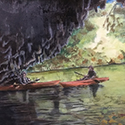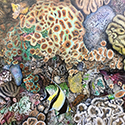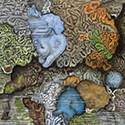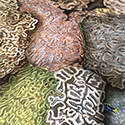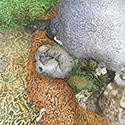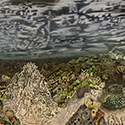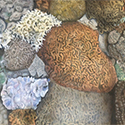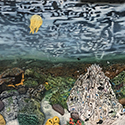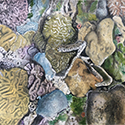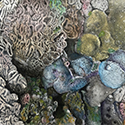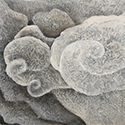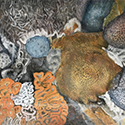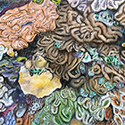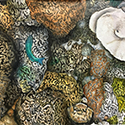How the ripple effect of a glassy Micronesian atoll caused
a first-time flood in Chicago
In a 2017 fortnight, I bonded with Micronesian phantasmagoric coral gardens while kayaking over glassy body-temperature water before fleeing through miles of the largest typhoon on earth. Palau piqued my curiosity to deep dive into how the Southern Ocean basins influence America’s weather. Friends and I snorkeled in atoll coves where plugs of coral were flourishing, repopulated giant clams in hidden havens, speared Crown of Thorns, and filled our gunwales with floating plastic. While UNESCO researched Palauan bounce-back coral, I painted polyp colonies to exhibit the extreme variety of interdependent organisms; fish, snakes, eels, turtles, sharks, and people in the coral reefs. Three years later my research plunge divulged a troubled convalescent ecosystem screaming to heal. 2020 weather is shriller with 29 Gulf hurricanes causing Midwest flooding, West Coast fires and mudslides, invasions of unknown killer insects and drought. Our climate and our resolutions originate in the unfathomable crannies of Micronesia.
Deep Southern Ocean basins absorb 93% of Anthropocene carbon emissions. The atmospheric carbon is transferred through ocean’s thin membrane to concoct toxic carbonic acid that debilitates ocean vitality. Warming oceans cool by forming larger cyclones, slow dawdling stirring currents, and bleach the verve and vigor of Earth’s most complex ecosystem -coral reefs. Polyps or soft bodied organisms like jellyfish attached their limestone skeleton to a rock and bud into thousands of clones over hundreds of centuries until a colony forms and joins with countless species to become a dynamic reef. Interdependent with ocean life; currents bring sundry polyps, fish clean and nourish, while the reef edifice protects shorelines from battering breakers. Palauan islands teem with stabilizing indigenous birds and insects that pollinate, fertilize and feed fish. Humans depend on reefs for storm protection, medicine, fishing and oxygen and return noxious aerated carbon.
Palau is an archipelago with each island independently governed and pursuing economic stability. The country became independent in 1994 yet retains United States currency, a Compact of Free Association with which the USA gives financial aid and protection while maintaining a military base. Eco-tourism assists the economy and offers fresh tourist energy for sustainable practices encouraged by Ron Leider who calls the coral bays,” mind-blowing technicolor in Einstein’s Bay and Galileo’s cove.” and MacStyle Sasao of Wilderness Travel who enlighten during Rock Island conservation kayak adventures. A UNESCO Heritage Site in Koror State of Palau is completing its three-year study of a protected coral reef that will be published in 2021.
Slowing our volatile weather will take decades to reverse if we act urgently. “The issue of climate has been the critical and existential issue of our times,” British Columbian, David Suzuki said in the Beyond Climate film. “The science has been in for over thirty years, and the denial, or at least the inability to take the big steps to move us in the right direction are not there.” The Southern Oceans are choking from Anthropocene excessive emissions while generating weather than endangers human life. Carbon Neutrality by 2050 promises oceans to cool after reversing the warming Greenhouse Effect by reducing carbon in the atmosphere. The root of El Nino and La Nina weather patterns is in Micronesia and its destabilized bio-network. Attention is focused on Palauan coral that bounced back from three major bleaching episodes. What can we learn before reefs don’t bounce back from increasingly warmer seas? Dr. Vaughan’s Summerland Key discovery of micro-fracturing coral triggers speedier growth to restore reefs with carbon-acclimated polyps. A deeper investigation of the threat, inquiry for determinations and broader exhibiting the wonders of the ocean may change human behavior faster while together.
I’d like to show paintings inspired by my adhering to Palauan corals’ myriad of colors and tell about the fear of racing away from the largest storm on Earth in 2017. My paintings capture how healthy coral looks where the miracle of bouncing back in Never-Neverland still exists. By looking more closely and discovering new research this article can share the intricate beauty, diversity and giving nature of coral that is calling out for help.
|







